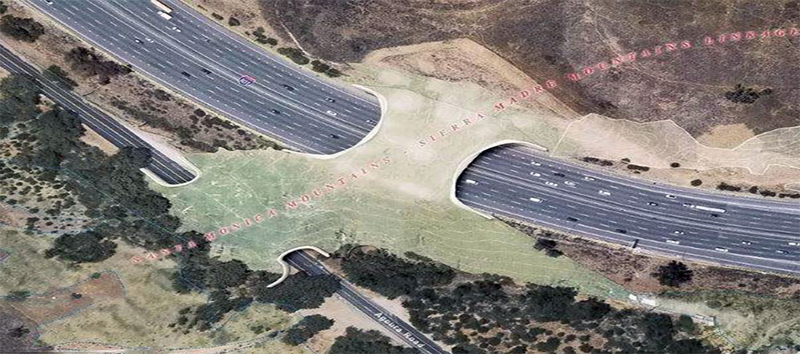Huge wildlife bridge project to start near L.A.
Come Earth Day, ground will be broken for a bridge over California’s 101 freeway in the Los Angeles area for wildlife.
A ground-breaking ceremony is scheduled Friday, April 22, for the Wallis Annenberg Wildlife Crossing. It will span eight lanes of highway plus two exit lanes. It is 200 feet long and 165 feet wide.
The Liberty Canyon Wildlife Crossing is billed as one of the largest urban wildlife crossings in the United States. It will connect the Simi Hills and the Santa Monica Mountains National Recreation Area.
“As the largest wildlife crossing of its kind in the world, it will provide lifesaving habitat connectivity to a broad array of animals for decades to come,” Wade Crowfoot, California secretary for natural resources, said in a news release from the National Wildlife Federation. “It also shows us what is possible when unique partners come together to think creatively, and then act boldly and decisively. I think we will look back decades from now and realize that this project galvanized a new era of conserving and reconnecting nature.”

A cougar roaming the area caught the ear of news media and the imagination of the public. It is referred to as P22. A #SaveLACougars campaign was conducted, and the website SaveLACougars.org created.
The project was a collaboration of Caltrans, the National Park Service, the Santa Monica Mountains Conservancy, Mountains Recreation and Conservation Authority, Resource Conservation District of the Santa Monica Mountains, and the National Wildlife Federation.
Philanthropist Wallis Annenberg and Annenberg Foundation issued a $25 million challenge grant to help fund the project. The bridge also has been called the Wallis Annenberg Wildlife Crossing.
The $87 million project is expected to be finished in 2025.
Caltrans also is considering wildlife crossings over U.S. 101 at Conejo Valley and at Rocky Peak and Moorpark on state Route 118.
Other wildlife crossing structures
It may be the newest and biggest wildlife crossing in the U.S., but the cougar crossing over Highway 101 in California is not the only one.
Here are others drivers may pass on the highway.
In western Colorado, two wildlife overpasses, five underpasses, and fencing with “escape ramps” for trapped animals have been built on state Highway 9. It was completed in 2016. A new wildlife overpass is planned for U.S. Highway 160 between Durango and Pagosa Springs.
In Nevada, nine crossings (bridges and tunnels) have been installed on I-80 between Wendover and Wells and U.S. 93 north of Wells in northeastern Nevada to reduce vehicle-animal collisions. The project was completed in 2018.
In Utah, the Parleys Summit wildlife overpass crosses over I-80 between Salt Lake City and Park City. It was completed in 2018. Utah completed the first wildlife overpass in the U.S. in 1975 on I-15 near Beaver. Since then, more than 60 wildlife crossings have been installed throughout the state. Many of them are tunnels or underpasses.
In Washington, a total of 27 wildlife crossing structures over 15 miles are included in plans for the Snoqualmie Pass project on I-90, part of a $1 billion highway renovation to be completed by 2029.
In 2012, the Wyoming DOT completed an $11 million project with two wildlife overpasses, six underpasses, and some 12 miles of fencing that funnels the animals to these safe crossings above or beneath the highway. A website is dedicated to live video feeds of traffic at Trappers Point Wildlife Overpass. LL









